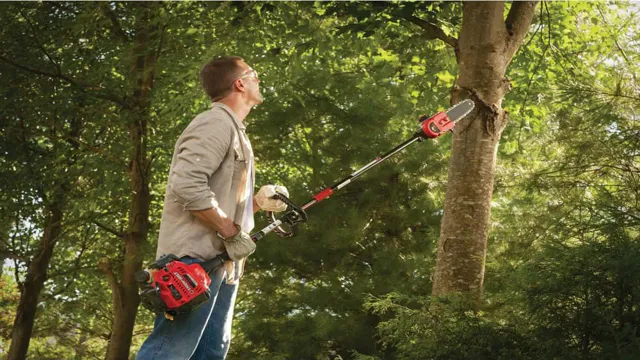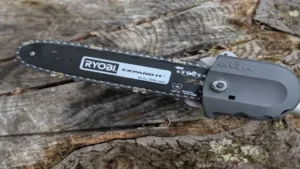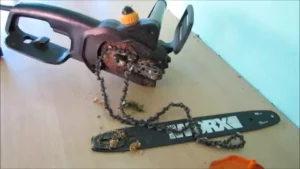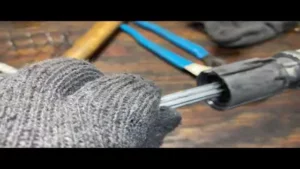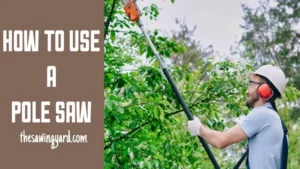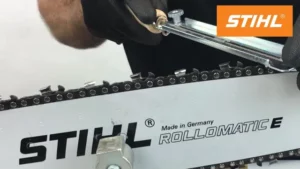If you’re looking to do some pruning or trimming in your backyard, a pole saw can be a great tool to have. But for those who have never used one before, it can be intimidating to figure out where to start. Fortunately, using a pole saw isn’t as daunting as it may seem.
In fact, it’s a lot like using a regular saw but with an extended reach. With a little bit of practice and knowledge, anyone can use a pole saw safely and effectively. So, if you’re ready to learn how to tackle those overhanging branches, keep reading for our beginner’s guide to using a pole saw.
Safety Tips Before Operating a Pole Saw
If you are preparing to use a pole saw for tree trimming, it is essential to follow safety protocols before operating it. Pole saws are powerful tools that can lead to serious injury if not handled properly. Before use, always inspect your saw for damages like cracks or broken parts.
Make sure to wear protective gear such as gloves, eye and ear protection, and a hard hat to keep yourself safe. Then, check the surrounding areas to avoid any potential hazards such as power lines, structures, or dead branches that can be unstable. Ensure that all parts are securely connected and tightened before starting the saw.
Also, take note of the saw’s reach and use it with due caution. Keep in mind that it’s best to operate it during the day when you can see the wood and branches clearly, and avoid using it in extreme weather conditions. By taking these precautionary measures, you’ll not only ensure the safety of yourself and others nearby, but also help prolong the life of your saw.
Inspect Pole Saw and Safety Gear
Before operating a pole saw, it is important to inspect both the tool and your safety gear. Start by checking the condition of the pole saw, ensuring that all parts are in good working order and that the blade is sharp. Make sure that the chain is not damaged or loose and that the saw is properly lubricated.
It is also important to check that the pole saw is securely attached to the pole and that the locking mechanism is functioning properly. Next, double-check that you have the proper safety gear including eye and ear protection, gloves, and a hard hat. Always wear closed-toe shoes with good traction to prevent slips and falls.
Remember, safety should be your top priority when operating any power tool, including a pole saw. By taking the time to check your equipment and gear, you are helping to minimize the risk of accidents and ensure a successful and safe pruning or trimming operation.

Clear the Work Area
Clear the work area is one of the safety tips to keep in mind before operating a pole saw. It’s essential to remove any debris that could interfere with your work, including rocks, branches, and other impediments. If the job site includes any foliage, consider pulling or tying it back out of the way to protect the cutters from getting snagged in the process.
Additionally, ensure that there are no bystanders or pets within the area. Non-slip footwear is also important as they will keep you secure while using the saw. Always move mindfully and cautiously when working with high-powered equipment like a pole saw to prevent injuries.
Remember to keep an eye on changing weather conditions, particularly high winds or a thunderstorm because they can complicate a saw work. By being mindful of these tips, you can stay secure and get the work finished effectively.
Operating a Pole Saw
If you have trees that need trimming, a pole saw is a handy tool to have. But how do you operate one? First, make sure you have the right equipment, including a hard hat, gloves, and proper footwear. Next, inspect the pole saw to make sure it is in good condition and the chain is properly tightened.
Before you begin cutting, identify any power lines or other hazards in the area. When you’re ready to start, grip the pole saw firmly with both hands and turn on the engine or battery. Be sure to keep the saw at a proper angle and use a fluid, sweeping motion to cut through branches.
Lastly, don’t forget to turn off the saw and store it in a safe place when you’re finished. By following these steps, you can safely and effectively trim your trees with a pole saw.
Adjust Pole Saw Length
When operating a pole saw, it’s important to adjust the length of the pole saw to suit your needs. Whether you’re trimming trees or pruning shrubs, the length of the pole saw can make the job much easier, safer, and more efficient. Adjusting the length of the pole saw is usually quite simple and straightforward, but it can make a big difference in terms of overall performance.
Most pole saws come with adjustable poles that can be extended or retracted as needed. This allows you to reach higher branches or trim shrubs that are closer to the ground. To adjust the length of the pole saw, simply loosen the locking mechanism and slide the pole up or down to the desired length.
Make sure the locking mechanism is secure before using the pole saw to avoid any accidents. By adjusting the length of the pole saw, you can work more comfortably, effectively and efficiently, and make the most of your garden tools.
Start the Pole Saw Safely
Operating a pole saw can be a bit intimidating for beginners, but with proper safety precautions and technique, it can be a useful tool for pruning and trimming trees. Before starting the pole saw, it’s important to ensure that the area around the tree is clear of any obstacles or people. Make sure you have a stable footing before lifting the pole saw, and grasp the handle firmly with both hands.
When ready, engage the saw blade and slowly guide it towards the area you want to prune. Always keep an eye on the saw blade, and avoid cutting branches that are too thick for the saw to handle. If you encounter any problems while operating the pole saw, shut it off immediately and seek assistance.
With these tips in mind, you’ll be able to safely operate your pole saw and keep your trees looking healthy and beautiful.
Select Proper Cutting Technique
Operating a pole saw can be a daunting task, but with the right cutting technique, it can be a breeze. First and foremost, it’s important to choose the right tool for the job. Make sure your pole saw is the appropriate length for the size of the branches you’ll be cutting.
When cutting, begin with the smaller branches first and work your way up to larger ones. Always make sure you have a clear path for the branch to fall. In terms of technique, it’s crucial to be aware of the angle of your blade.
When making a cut, tilt the blade slightly away from the direction you want the branch to fall. This will help ensure a clean cut and prevent the blade from getting stuck. Remember to take breaks and stay hydrated, as operating a pole saw can be physically demanding.
By following these tips, you’ll have a successful and safe experience using your pole saw.
How to Maintain and Store Pole Saw
Operating a pole saw can be quite tasking, which is why it is crucial to know how to maintain and store it properly to ensure it lasts for a long time. To start, you should ensure that the blade is sharp at all times to make the cutting process smoother and easier. After using the pole saw, clean off any debris or sawdust that may have accumulated on the blade to prevent rust.
Also, lubricate the pivot points and blade with oil to keep them operating smoothly. When it comes to storage, always store the pole saw in a dry and cool place. Avoid keeping it in a damp location as it can lead to rust and damage.
Additionally, store the pole saw with the blade’s guard on to protect against accidental injury or damage to the blade. By properly maintaining and storing your pole saw, you can guarantee its longevity and operational efficiency, making it a worthwhile investment for any landscaping enthusiast or professional.
Clean and Sharpen Blade
Maintaining and storing your pole saw properly can extend its life and ensure efficient performance. One of the essential maintenance tasks is cleaning and sharpening the blade. Regular cleaning can prevent rust and corrosion and ensure that the blade stays sharp, which is essential for cutting through thick branches.
To clean the blade, use a cloth or brush to wipe away any debris, sap, or dirt. You can also use a solution of warm water and soap to clean the blade thoroughly. After cleaning, dry the blade with a towel and apply a thin layer of oil or lubricant to prevent rust.
To sharpen the blade, use a file or sharpening stone to remove any nicks or dull edges. Sharpen the blade at an angle and follow the manufacturer’s instructions for the proper technique. It’s essential to store your pole saw properly in a clean and dry place to prevent damage and rust.
Make sure to clean and dry it before storing and detach the blade from the saw for safe storage. By following these maintenance and storage tips, you can ensure that your pole saw is always ready when you need it.
Store the Pole Saw in a Safe Place
If you own a pole saw, it is important to store it in a safe place to keep it in good condition and prolong its lifespan. Before storage, clean the saw and remove any debris or dirt that may have accumulated on it during use. Make sure the blades are well-sharpened and lubricated to prevent rusting and corrosion.
When storing the pole saw, keep it in a dry, well-ventilated place away from direct sunlight or damp conditions. If possible, store it in a case or cover it with a tarp to protect it from dust and moisture. Remember to also store the saw with the blade covered or secured to prevent accidental cuts.
Proper storage and maintenance of a pole saw will ensure that it is always ready for use when needed.
Conclusion
In conclusion, operating a pole saw can be a thrilling experience reminiscent of fighting off zombies with a chainsaw. However, it’s important to remember that safety comes first! Always wear protective gear, be mindful of your surroundings, and don’t attempt to saw off more than you can handle. With the right technique and a little bit of badassery, you’ll have those pesky branches trimmed in no time.
Cheers to channeling your inner lumberjack and mastering the art of the pole saw!”
FAQs
What is a pole saw and how does it work?
A pole saw is a gardening tool that combines a chainsaw and a long pole for pruning high branches or trees. The saw is powered by either electricity or gas, and the blade is attached to the end of the pole for cutting limbs from a distance.
What are the safety precautions that should be taken when using a pole saw?
It is important to wear protection gear such as a helmet, goggles, and gloves when using a pole saw. Make sure to keep a safe distance from the cutting area and avoid using the saw on unstable surfaces or during adverse weather conditions.
How can I maintain my pole saw?
Regular maintenance is crucial to ensure the longevity and effectiveness of your pole saw. Keep the blade sharp, check the chain tension, and lubricate the chainsaw regularly. Also, inspect and clean the saw after each use to prevent any dirt or debris buildup.
How high can a pole saw reach?
The maximum height that a pole saw can reach depends on the length of the pole. Pole saws can range in length from 6 feet to over 15 feet, allowing them to reach heights of up to 20 feet or more.
Can a pole saw be used to trim bushes or shrubs?
Yes, a pole saw can be used for pruning smaller trees, bushes, and shrubs. However, it is important to adjust the length of the pole accordingly and use caution to avoid damaging the surrounding foliage.
What is the difference between an electric and gas-powered pole saw?
Electric pole saws are quieter, lighter, and require less maintenance than gas-powered options. However, they are limited by the cord length and power output. Gas-powered pole saws are more powerful and versatile, but they are heavier and require more maintenance.
Can I use a pole saw to cut down a tree?
No, a pole saw is not suitable for cutting down large trees. It is designed for pruning and cutting smaller branches and limbs. For larger trees, it is best to hire a professional tree removal service.
